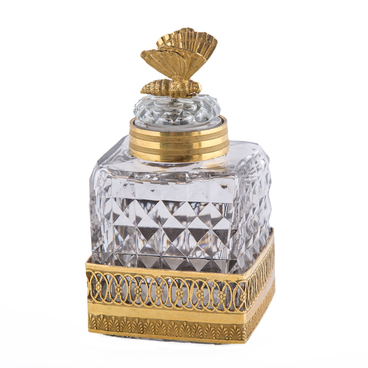In 1918, from the estate of Counts Uvarov “Red Mountain” in the village of Karacharovo, the Sevres service “Tete-a-tete” entered the museum collection.
The name “service” came to Russia from the French language — it is a set of dishes designed for a certain number of guests. Tea set for two persons “Tete-a-tete” derives from the French word “alone”, literally “head to head”.
The teapot has cobalt coating, molded details on the handle and lid, and mascaron under the spout. The complex shape of details is emphasized by gold lines; the lid and crown have gold layering finishes in the form of small gold festoons, characteristic of Sevres. The teapot is decorated with an elegant little relief painting with white arabesques with gold trimmings. The bottom of the kettle has a stamp with the date of firing — 1884 and the year of painting — 1890; in the test there is a handwritten inscription — “A V 84 …”, probably it is the sign of the master who worked on the form.
The service items were made at the porcelain manufactory in Sevres in 1883-1890.
The Sevres porcelain manufactory was founded in 1740 in the Castle of Vincennes, east of Paris. In 1756, the company moved to a specially built factory in Sevres near the castle of Madame de Pompadour, mistress of Louis XV and an influential patroness of the factory. The factory is still operating there. Sevre porcelain products are considered to be one of the most beautiful examples of decorative and applied art in Europe.
One of the Sevre colors is dark blue, made on the basis of cobalt. The earliest blue color of Sevre is “bleu lapis” (blue malachite), first applied in 1751. In the 1770s, the color began to be called “gros bleu” (dark blue). The popular solid dark blue primer “beau bleu”, applied to the glazed surface, began to be used since 1768. Since the beginning of the 1780s, “fond Noir”, a blue-black pigment obtained from iron and cobalt, has been used to simulate a black Chinese background (wujing).
In the middle of the XIX century, the Sevra manufactory developed the pate-sur-pate technique — painting with a liquid porcelain mass (slip) on a colored background, for coloring which, as a rule, cobalt was used.
The name “service” came to Russia from the French language — it is a set of dishes designed for a certain number of guests. Tea set for two persons “Tete-a-tete” derives from the French word “alone”, literally “head to head”.
The teapot has cobalt coating, molded details on the handle and lid, and mascaron under the spout. The complex shape of details is emphasized by gold lines; the lid and crown have gold layering finishes in the form of small gold festoons, characteristic of Sevres. The teapot is decorated with an elegant little relief painting with white arabesques with gold trimmings. The bottom of the kettle has a stamp with the date of firing — 1884 and the year of painting — 1890; in the test there is a handwritten inscription — “A V 84 …”, probably it is the sign of the master who worked on the form.
The service items were made at the porcelain manufactory in Sevres in 1883-1890.
The Sevres porcelain manufactory was founded in 1740 in the Castle of Vincennes, east of Paris. In 1756, the company moved to a specially built factory in Sevres near the castle of Madame de Pompadour, mistress of Louis XV and an influential patroness of the factory. The factory is still operating there. Sevre porcelain products are considered to be one of the most beautiful examples of decorative and applied art in Europe.
One of the Sevre colors is dark blue, made on the basis of cobalt. The earliest blue color of Sevre is “bleu lapis” (blue malachite), first applied in 1751. In the 1770s, the color began to be called “gros bleu” (dark blue). The popular solid dark blue primer “beau bleu”, applied to the glazed surface, began to be used since 1768. Since the beginning of the 1780s, “fond Noir”, a blue-black pigment obtained from iron and cobalt, has been used to simulate a black Chinese background (wujing).
In the middle of the XIX century, the Sevra manufactory developed the pate-sur-pate technique — painting with a liquid porcelain mass (slip) on a colored background, for coloring which, as a rule, cobalt was used.



